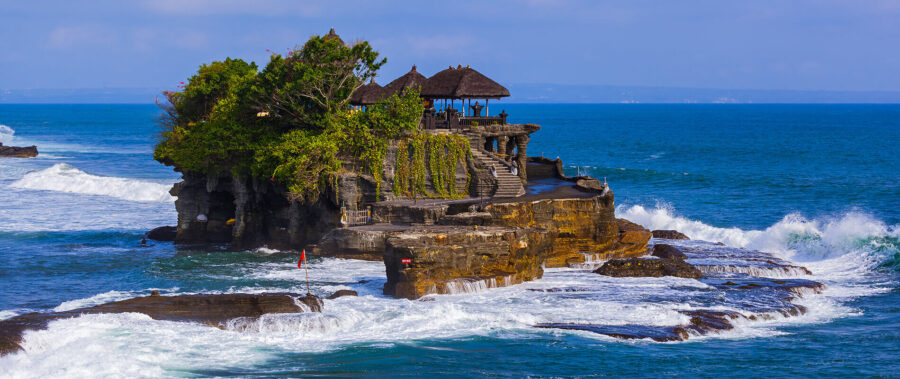Introduction
Nestled on the southwestern coast of Bali, the island of the gods, Pura Tanah Lot stands as a testament to the spiritual and cultural richness of Indonesia. This temple, perched atop a rock formation amidst the Indian Ocean, is not just a religious site but an emblematic landmark that attracts thousands of visitors yearly. This article delves into the deep-rooted history, architectural marvels, cultural significance, and the unique natural beauty that surrounds Pura Tanah Lot, ensuring an engaging and informative read for those intrigued by Balinese culture and heritage.
The Historical Tapestry of Tanah Lot

The origins of Pura Tanah Lot are steeped in legend and history, tracing back to the 16th century. It is said that the temple was founded by a revered Javanese Hindu priest, Nirartha, who arrived on Bali’s shores from Java, spreading the teachings of Hinduism. One of the most popular legends tells that Nirartha, upon reaching Tanah Lot, decided to use the power of meditation to ward off sea spirits, creating the temple on a rock to serve as a protective barrier for Bali.
Nirartha instructed the local Balinese to build a shrine on the rock, which over centuries evolved into the temple complex we see today. Another enchanting tale describes how he transformed his sash into a venomous snake to guard the temple, a tradition that continues with the presence of holy sea snakes believed to protect the temple to this day.
Architectural Wonder on the Waves
The architecture of Pura Tanah Lot is a splendid example of Balinese temple design, characterized by its multi-tiered meru roofs, signifying the mountain homes of the gods. The temple itself is built on a large offshore rock, accessible by a causeway during low tide, adding to its mystical allure. The structure includes several shrines, the most iconic being the main shrine, which is dedicated to the sea god Baruna.
The strategic placement of the temple not only serves a spiritual purpose but also showcases the Balinese mastery over landscape architecture, harmonizing the man-made with nature’s majestic backdrop. The temple’s design respects the Balinese concept of Tri Hita Karana, which emphasizes harmony among humans, nature, and the gods.

Cultural Significance and Ceremonies
Tanah Lot is more than just a scenic spot; it’s a pivotal point in Bali’s spiritual life. It is one of the seven sea temples around Bali’s coast, each connected visually or spiritually to form a protective chain against malevolent sea spirits. The temple plays a central role during major Balinese Hindu festivals like Galungan and Kuningan, where ceremonies are held to honor the ancestors and deities.
The temple’s rituals involve offerings, prayers, and dance performances, with one of the most visually striking being the Kecak dance, performed against the backdrop of the setting sun. These cultural practices not only keep the traditions alive but also offer visitors a unique window into Balinese spirituality.
The Natural Beauty and Ecological Surroundings
The area around Tanah Lot is as captivating as the temple itself. The landscape is dotted with black sand beaches, cliffs, and caves, each contributing to the temple’s mystical ambiance. The natural phenomena here include the tidal pools that form around the temple’s base, teeming with marine life, and the dramatic sunsets that paint the sky in hues of orange and pink, making it a photographer’s paradise.
The ecology of the region is also noteworthy, with conservation efforts aimed at protecting the local flora, fauna, and maintaining the integrity of this natural wonder. The presence of holy sea snakes adds an element of intrigue and biodiversity to the area.
Tourism and Visitor Experience
Pura Tanah Lot has evolved into one of Bali’s top tourist attractions, drawing visitors from around the globe. The site offers various amenities like souvenir shops, restaurants serving local cuisine, and cultural shows. However, the experience is managed to keep the sanctity of the temple intact. Visitors are encouraged to respect local customs, such as dressing modestly, especially when entering sacred areas.
Guided tours provide insights into the temple’s history and significance, enhancing the visitor’s appreciation of this cultural gem. For those who visit at sunset, the experience is particularly magical, as the temple seems to float on water amidst the golden light.
Conclusion
Pura Tanah Lot encapsulates the essence of Balinese culture, where spirituality meets natural beauty. It stands as a beacon of history, art, and tradition, inviting all to witness not just a temple, but a living narrative of Bali’s soul. Whether you’re there for its architectural splendor, the cultural depth, or simply to witness one of nature’s most picturesque settings, Tanah Lot promises an experience that is as enriching as it is unforgettable. Remember, a visit here isn’t just a journey through space but through time, connecting the past with the present in the most scenic of settings.


